People do a lot of things they don’t ever speak of. And for a lot of different reasons. If you look at all the different little things people do, the threads of their lives, really— don’t they all come together like a fancy garment? Perhaps a little like a secretive glance into their private life? A little bit like a peak at their Intimate Apparel? Returning to live, in-person theatre, Dundalk Community Theatre brings Lynn Nottage’s Intimate Apparel to the stage under the direction of Tom Colonna, and it gives a glimmering glimpse into the lives of six characters living in New York City in 1905. Lynn Nottage is a powerful playwright; she is truly an author of the times, putting poignant work on stages that has meaning, has feeling, and has a great deal of emotion to be experienced by those in the audience. For this production, some of the production elements, casting choices, and overall handling and direction of the show fall short of what Nottage’s work could deliver and achieve.
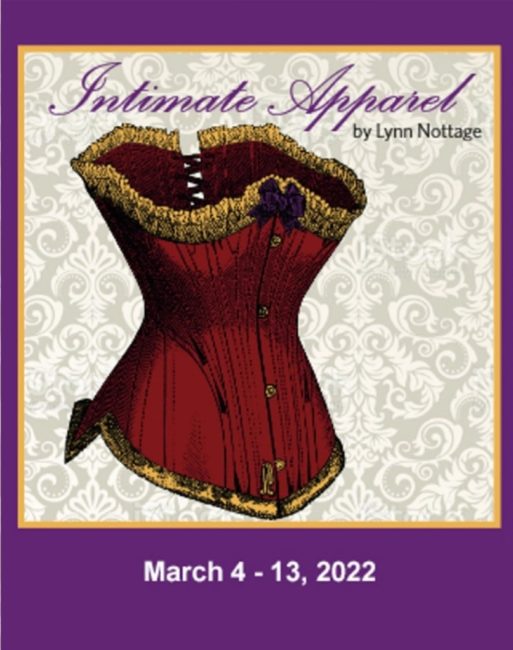
Ultimately Dramaturg Precious Stone fails the production and by proxy the designers of the show with a great many historical anachronisms that pop up and serve as major distractions throughout the performance. While research may show that, yes a version of ‘the zipper’ was in play in garments as early as the mid-to-late 1800’s, they were not popularize or mainstraimed, and didn’t really catch on until well into the 1910’s. Costume Designer Sharlene Michelle Clinton (and assistants James J. Fasching and Della Lotman) have fitted each of the actresses’ corsets with front-facing zippers. This wouldn’t be an issue for those corsets if we never saw them being removed. Clinton may make the argument that this is done for ‘ease of quick costume change.’ But as these costume changes are happening on stage with plenty of text built around them on either side for the proper lacing of corsets (with one scene even including an elaborate display of one character tugging on another character’s strings to get the garment fitted properly into place) the choice to have them ‘zipped off’ looks sloppy and modern. The same can be said for the ‘fishnet stockings’ featured on Mayme; while history can route ‘fishnets’ back to the early 1900’s, the broad, wide-cross variety used in this production casts a glaring modern feel on the character.
Each of the characters is featured in a period appropriate wig, except for the main character, Esther, whose natural hair is styled in tight-to-the-scalp braids and gathered into a bunch in the back. This wouldn’t be an issue if this was the style of 1905 and you might even get away with not noticing this choice if the other five characters in this six-character show didn’t have lavishly styled period-appropriate wigs. Why Hair Stylist Barry Stairs chose not to provide a period-appropriate wig for the main character, or even an era-appropriate style with the actresses’ own hair remains a mystery, considering the look that went into the other hair styles in the show.
The show’s Sound Design (Marc W. Smith) is another mixed and problematic bag that recurs throughout the performance. While there were no major microphone malfunctions, the balance of background sound effects was never quite right, and there were a great many missed opportunities to utilize more creatively placed sounds. Smith, to his credit, did use a catchy ragtime clip between scenic transitions, however, this could have been switched up more frequently. The ‘party noise’ at the beginning was so loud it was distorting the opening exchange of dialogue, and the ‘rain’ (the only time there was ever any sound scored underneath George Armstrong’s letters from the Panama Canal despite all the sounds he described in them) was so distorted it sounded more like an HVAC vent than precipitation.
To Smith’s credit, as he served as the show’s Set Designer and Lighting Designer, those portions of the design were quite stunning, rather breathtaking truthfully, and set high expectations and hopes for the overall production value. The set was striking, with sectioned platforms that delineated each unique scenic space while allowing them to simultaneously coexist on the same stage. The boudoir parlor for Mrs. Van Buren was as classy as the ‘Saloon Room’ for Mayme was sleazy and cheap. The little shop for Mr. Marks was cluttered but cozy, and the tiny, tucked away tent-campsite to represent the scenes in the Panama Canal was shoved deep between two of these scenic rooms, creating the illusion that it truly was in a place far away. Smith’s Lighting was spot on, delicate and poised, highlighting different moments of weight that were featured in the script.
Director Tom Colonna could have tightened the show’s overall pacing, particularly in scenes that featured Mrs. Dixon (Lisa Jenkins). Often these scenes dragged on and while it was perhaps that Colonna was trying to emphasize the character’s age or gossipy, verbal-meandering nature, this did not read clearly. There were also a few scenes where Jenkins unfortunately lost her place in the script or lost her lines and silence ensued. These mistakes would have been easy enough to overlook if Colonna had driven a more spitfire pace throughout the production. The devil is in the details and when the pacing of any show is sluggish or delayed, the audience has more time to gaze around the set, stare intently at costumes, and home-in on any and every little mistake, historic anachronism, or otherwise unfinished detail that the production has to offer.
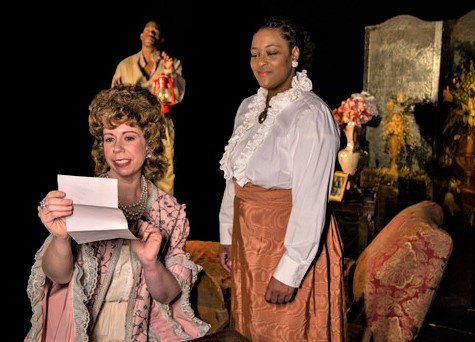
The show also appeared to have ‘intimacy issues’, which is ironic for a show called Intimate Apparel. And this is not a comment on the deliberate moments of intentional intimacy issues— like when George and Esther are first together or when Esther accidentally touches Mr. Marks— this is surrounding all the other intimate moments that occur in the performance. It reads very loudly like the actors do not feel comfortable being that close to one another or touching/kissing/hugging one another in the way that the show calls for. Whether this is because there was a lack of an Intimacy Coordinator on the production staff or Colonna’s directorial call because of Covid Safety Concerns, is unclear. But if it’s the former, that’s a short-sighted mistake, and if it’s the latter, a different production should have been chosen for this current production slot.
As Esther Mills, Takira Thompson presents a more modern-sounding character than fits the dialogue written into Nottage’s script. While there’s no particular accent indicated (the character makes mention of growing up in the south and making her way to New York it is not overtly specified the way Mrs. Van Buren’s ‘southern peach’ drawl is identified) for Esther Mills, there is just something about the way that Takira Thompson delivers her lines that gives them a primed feeling of modernity. This happens primarily in scenes with the Mrs. Dixon character. The dialogue exchanges between George Armstrong and Esther Mills, during the second act, also feel stilted, though this read as more of a slight discomfort with trying to navigate the physical intimacy and closeness of staging during Covid-times rather than a strong directorial choice or lack thereof. Thompson does have several moments, particularly when she’s absorbing details or describing fabric that feel grounded in her character’s reality.
Playing the aforementioned George Armstrong, Ryan Holmes does an extremely impressive job delivering and steadily maintaining the Caribbean accent of his character. The shift from George Armstrong in the first act, where he is only ever seen under the tent, corresponding with Esther through letters, to how he appears in person is astonishing and deliciously mercurial. Holmes delivers some of the more engaging moments in the production and has a very commanding presence on the stage. The one complaint about Holmes’ performance is that during the completely shirtless scene, all of his very modern tattoos can be seen clearly on his torso and shoulders. As the blocking of this scene implies that ‘consummation of the marriage’ is about to occur, the full removal of his shirt becomes unnecessary and adds to the list of historical inconsistencies given the visibility of his tattoos.
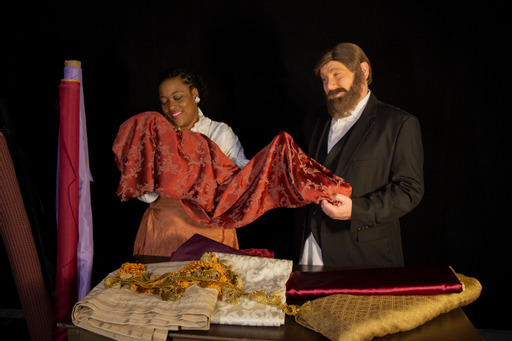
In a surprisingly endearing role, Toby Hessenauer plays the affable and somewhat hapless Mr. Marks, a Jewish fabric salesman with whom Esther shares a series of beautifully (and intentionally) awkward exchanges. While Hessenauer’s character is probably featured the least, his moments on stage are very heartwarming and delightful to digest. Hessenauer does a terrific job of puttering about in the tiny shop, making a great production out of misplacing things or mislaying fabrics. His Yiddish-Jewish accent is spot on and much like Holmes’ Caribbean one, delivered with great consistency throughout his performance. Each character only ever interacts with Esther, so you only get to see these characters through that lens, but Hessenauer creates a meaty depth to the Mr. Marx character, giving him a thriving human vulnerability that makes the character worth investing in.
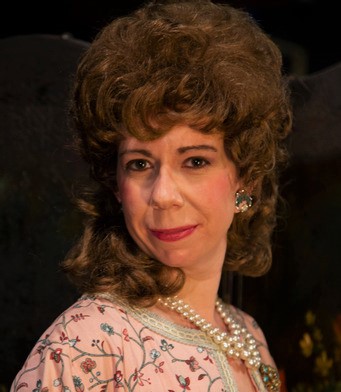
Giving one of the two strongest performances in the production, Laura Weiss as the eccentric, albeit aloof, Mrs. Van Buren is giddy and jovial to watch. Again with a flawlessly, albeit exaggeratedly, executed ‘southern belle’ accent, Weiss brings a lively and bubbly nature to her character. While the character at first may seem easily dismissible as this fluffy bit of extemporanea, Weiss delivers one of the show’s most shocking surprises, which for fear of spoiling won’t be mentioned here. There is something uniquely layered about the way Weiss brings Mrs. Van Buren to the stage, one thing on the surface— like her outer robes of chiffon and silk— and quite another underneath— like the glossy and provocative corsets she wears beneath those boudoir robes.
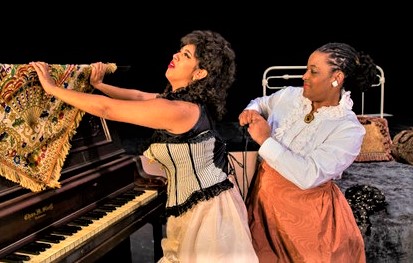
In the show-stealing role of Mayme, Randi Seepersad delivers a volatile spectacle of a character, giving the audience much to consider when it comes to the old adage of judging a book by its cover. While there is no sugar-coating the fact that the Mayme character is a prostitute, Seepersad makes the audience look at her character like a human being with layers. With a keen understanding of the 1905-dialect Lynn Nottage has written into the play, and an even sharper delivery, Seepersad sounds as if she stepped right out of a time machine and onto the stage. Giving a strikingly versatile performance, it is astonishing to see how carefree, silly, and full of laugh-giving lines she can be only to witness those characteristics turned on their head during a woeful and eviscerating confession of tears and emotions in the second act. Seepersad is the uplifting jolt and heart-destroying anchor that brings this show up and down.
Despite the show’s issues with pacing, dialogue delivery, and historical anachronisms, there are good, solid performances and Lynn Nottage’s brilliant writing and overall message is very much worth experiencing. The production has a limited run engagement for two weekends through the 13th of March, 2022.
Running Time: Approximately 2 hours and 20 minutes with one intermission
Intimate Apparel plays through March 13, 2022 at Dundalk Community Theatre located on the campus of the Community College of Baltimore County Dundalk in the John E. Ravekes Theatre— 7200 Sollers Point Road in Dundalk, MD. Tickets are available for purchase by calling the box office at (443) 840-2787 or by purchasing them in advance online.
